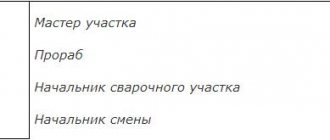The job description of a civil engineer lists the range of tasks he solves, and also describes the rights and responsibilities for violations. The instructions are recommended for use by Rostrud, and their availability is checked during inspections by the Pension Fund of Russia and the Social Insurance Fund. In addition, it can also be used in labor proceedings in judicial and administrative formats.
- Form and sample
- Free download
- Online viewing
- Expert tested
FILES
Sample job description for civil engineer
General provisions
- A civil engineer is hired and fired by the head of the company.
- The civil engineer reports to the chief engineer.
- The applicant for the position must meet the following requirements:
- higher (secondary specialized) construction education;
- One year of experience in the construction industry.
- During the absence of a specialist (treatment of illness, business trip, etc.), his professional functions are transferred to another employee appointed by the chief engineer.
- A civil engineer is required to know:
- laws and regulations governing the construction industry;
- basics of working with the “Unified System of Technological Preparation of Production” (USTPP);
- professional standards and rules;
- methods of working with profile documentation;
- fire and technical safety standards;
- methods for carrying out the necessary calculations and measurements, as well as checking their quality;
- seasonal, weather and other factors affecting construction activities;
- criteria for assessing the quality of work performed;
- main parameters of technical specifications (TOR);
- features of different materials and structures used in construction;
- typical timing of stages of construction activities;
- standards for resource consumption during construction work;
- stages of organizing construction activities;
- specifics of the main types of construction work;
- features of work on the construction of objects of different types;
- best practices in construction;
- rules for working with drawings;
- methods of using appropriate programs for the necessary calculations;
- rules for interaction with colleagues to resolve construction-related issues.
- economic parameters of construction activities.
- The civil engineer focuses on:
- current legislation;
- industry regulations;
- company documents;
- provisions of this instruction.
Functions
The civil engineer is responsible for the following tasks:
- Processing of technical documentation for construction activities.
- Development and coordination of design solutions.
- Monitoring compliance with industry regulations and standards when performing work.
- Planning the schedule and stages of necessary work.
- Coordination of construction projects with contractors.
- Participation in the acceptance of constructed objects.
- Preparation of technical specifications according to your profile for third-party contractors.
- Participation in the examination of specialized tasks performed by third-party agents.
- Carrying out technical calculations.
- Participation in preparing the company for construction tenders.
- Monitoring the availability of necessary permits and documents.
- Development of construction estimates in accordance with established parameters.
- Monitoring the compliance of the work performed with drawings and diagrams.
- Implementation of measures to improve construction work.
- Participation in ongoing inspections of facilities under construction and operation.
- Interaction with colleagues to resolve production issues.
- Monitoring trends in the field of construction activities.
- Monitoring the quality of construction and repair work performed by the company.
- Compliance with technical and fire safety rules, as well as labor discipline standards.
Responsibility
A civil engineer is held accountable for:
- Violations of current laws and regulations - in accordance with articles of criminal, labor or administrative law.
- Transfer of internal information to third parties - in accordance with company rules and sections of legislation.
- Failure to perform relevant job functions - within the limits specified in labor legislation.
- Causing material harm to the employer - within the limits specified in the relevant legislation.
Rights
A civil engineer has the following capabilities:
- Suggest measures to improve your activities.
- Request from colleagues information necessary for current work.
- Require management to create conditions necessary for professional activities.
- Inform the chief engineer and other managers on problematic issues in their area of responsibility.
- Require access to the criteria by which his achievements are assessed (KPI).
- Have access to draft corporate documents related to your activities.
- Give orders, in agreement with the heads of the relevant departments, to other specialists.
- Sign inspection and acceptance reports, defective statements, and other relevant documents.
Job Description for Construction Engineer
Job Descriptions
Open in WORD format
1. GENERAL PROVISIONS 1.1. This job description defines the functional duties, rights and responsibilities of the Construction Engineer. 1.2. A construction engineer is appointed and dismissed in accordance with the procedure established by current labor legislation by order of the director of the enterprise. 1.3. The construction engineer reports directly to ________________________________. 1.4. A person with a higher professional (technical) education and work experience in the field of construction of at least ____ years is appointed to the position of Construction Engineer. 1.5. A construction engineer must know: legislation and other regulations governing the activities of construction organizations; profile, specialization and features of the enterprise structure; prospects for technical and economic development of the enterprise; production capacity of the enterprise; fundamentals of work technology; the procedure for developing and approving construction plans; technology and methods of construction work; building regulations; labor organization requirements during the construction of construction projects; the procedure for developing and processing design estimates and other technical documentation, maintaining records and drawing up reports on the enterprise’s activities in the field of construction; the procedure for concluding and executing economic and financial contracts; scientific and technical achievements and experience of leading enterprises in the field of construction; economics, organization of production, labor and management; rules and regulations of labor protection, safety, industrial sanitation and fire protection. 1.6. During the period of temporary absence of the Construction Engineer, his duties are assigned to ____________________________________. 2. FUNCTIONAL RESPONSIBILITIES Construction engineer: 2.1. Provides technical supervision over the implementation of construction and installation works, acceptance of work and completed objects. 2.2. Monitors the progress of construction plans, compliance of the volumes, timing and quality of construction and installation work, as well as the quality of the materials, products, structures used with the approved design and estimate documentation, working drawings, building codes and regulations, standards, technical conditions, labor safety standards. 2.3. Participates in resolving issues of making changes to projects in connection with the introduction of more advanced technological processes, space-planning and design solutions that ensure cost reduction and improvement of technical and economic indicators of construction and reconstruction projects. 2.4. Takes part in the consideration and approval of changes to design solutions that arise during construction, promptly resolves issues regarding the replacement, if necessary, of materials, products, structures (without reducing the quality of construction projects). 2.5. Studies the reasons causing delays and deterioration in the quality of construction and installation work, takes measures to prevent and eliminate them. 2.6. Carries out technical acceptance of completed construction and installation works and objects, draws up the necessary technical documentation. Participates in the work of commissions for the acceptance of construction projects and their commissioning. 2.7. Monitors the quality of elimination of imperfections and defects within the established time frame. 2.8. Keeps records of completed construction and installation works and prepares the necessary data for reporting on the implementation of construction plans. 3. RIGHTS A construction engineer has the right: 3.1. Give instructions and tasks to his subordinate employees and services on a range of issues included in his functional responsibilities. 3.2. Monitor the implementation of planned tasks and work, the timely completion of individual orders and tasks by subordinate units. 3.3. Request and receive the necessary materials and documents related to the activities of the Construction Engineer and his subordinate units. 3.4. Enter into relationships with departments of third-party institutions and organizations to resolve operational issues of production activities that are within the competence of the Construction Engineer. 4. RESPONSIBILITY The construction engineer is responsible for: 4.1. The results and efficiency of the enterprise's production activities within its competence. 4.2. Failure to ensure the fulfillment of his functional duties, as well as the work of subordinate divisions of the enterprise regarding their production activities. 4.3. Inaccurate information about the status of implementation of work plans on issues within his competence. 4.4. Failure to comply with orders, instructions and instructions from the administration of the enterprise. 4.5. Failure to take measures to suppress identified violations of safety regulations, fire safety and other rules that pose a threat to the activities of the enterprise and its employees. 5. WORKING CONDITIONS 5.1. The work schedule of a Construction Engineer is determined in accordance with the Internal Labor Regulations established at the enterprise. 5.2. Due to production needs, the Construction Engineer may go on business trips (including local ones). 5.3. To resolve operational issues to ensure production activities, the Construction Engineer may be allocated company vehicles. 6. SCALE OF ACTIVITIES AND IMPACT OF DECISIONS 6.1. To ensure his activities, a construction engineer is given the right to sign organizational and administrative documents on issues included in his functional responsibilities. I have read the instructions ___________________ (signature)
Rules for drawing up a document
In modern practice, two job description formats are used: standard and extended. The first option, which is most common, includes:
- General part.
- Functions of a specialist.
- His responsibility.
- Labor rights.
In the extended format, the employer adds some sections from the following list:
- Parameters of job relationships.
- Features of work activity.
- Rules for assessing achievements (KPI).
The extended version of the instructions is used in large businesses, as well as for management positions and unique specialists. It relieves employers of the need to explain their professional specifics to employees individually.
Attention! It is recommended to print out the job description on corporate letterhead, which contains the main official attributes: date of preparation, positions and signatures of managers approving the contents of the document, company details, etc.
a common part
Here are the general parameters of a specialist’s professional activity:
- The procedure for his hiring and dismissal.
- Rules of subordination and temporary replacement.
- What provisions does he follow?
- Skills expected from him.
- Required level of professional experience and education.
Some of these paragraphs are drawn up individually, in accordance with the specific requirements of the employer. This especially applies to the required skills, which must ensure the high-quality performance of professional tasks set out in the next section.
Responsibilities
The content and scope of this section depends heavily on factors such as:
- Industry and professional specifics.
- Personnel policy practiced by the employer.
- The value of a specialist.
- The scale of the company’s activities and its organizational and legal form.
Thus, in a small business, the employee is often entrusted with resolving minor issues. In large companies, employees are expected to concentrate on core tasks. And some of the functions are mandatory for any position: compliance with technical safety rules, labor protection standards, etc.
Attention! As a guideline for describing the job characteristics of a civil engineer, you can use professional standard 16.032, approved by the Ministry of Labor on November 27, 2014. The use of professional standards in work activities is determined in Articles 195.1-195.3 of the Labor Code.
Responsibility
This section describes options for holding an employee accountable for violations committed at work. Usually the section consists of 3-4 paragraphs, where the most common offenses are formulated. For a number of positions, responsibility for violating confidentiality rules is separately prescribed.
Rights
This part contains a list of rights given to a specialist by his employer. The content of the list and its volume depend on the professional specifics, the employee’s place in the company structure and other factors. Typically, the larger the range of tasks an employee solves, the more job opportunities he has.
The job description can be drawn up on an individual basis or in accordance with approved regulations. In any case, it goes through a number of stages:
- Preparing a draft.
- Its consideration with the participation of a lawyer, HR employee, and specialized managers.
- Preparation of the final version, taking into account the amendments received.
- Coordination of the clean draft with managers and specialists.
- Signing of the document by the head of the company.
At the final stage, the specialist himself signs, agreeing with the provisions of the instructions. This usually happens when he is hired.



